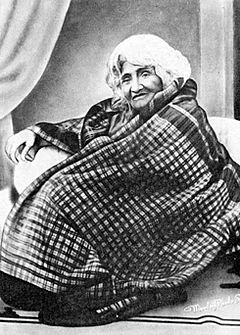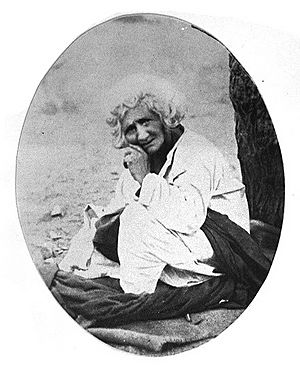Hazrat Babajan facts for kids
Quick facts for kids
Hazrat Babajan
|
|
|---|---|

Pune, India
|
|
| Born |
Balochistan, Afghanistan
|
| Died | 21 September 1931 |
| Era | 20th century |
| Region | India |
| School | Sufism |
|
Influences
|
|
|
Influenced
|
|
Hazrat Babajan (Balochi: حضرت باباجان) was a very respected Pashtun Muslim spiritual leader. Her followers believed she was a special kind of saint, like a Sadguru or Qutub, which means a perfect spiritual guide. She was born in Balochistan, Afghanistan. She spent the last 25 years of her life in Pune, India. She was also the first spiritual teacher of Meher Baba, another famous spiritual master from India.
Contents
Early Life and Spiritual Journey
Hazrat Babajan was born with the name Gulrukh, which means "Face like a Rose." She came from a wealthy and important family in Balochistan, Afghanistan. We don't know her exact birth date, but it was likely sometime between the late 1700s and early 1800s.
She received a good education for her time. She could speak Arabic, Persian, Urdu, and her native Pashtu. She was also a hāfiżah, meaning she had memorized the entire Quran, the holy book of Islam. From a young age, she was very spiritual. She loved to pray, meditate, and spend time alone, which was different from other girls her age.
When she was about eighteen, her family arranged a marriage for her, which was a common custom. But Babajan didn't want to marry. So, on her wedding day, she ran away from home. She dressed in a burqa (a traditional covering) to hide her identity. She traveled to Peshawar, a city near the Khyber Pass.
In Peshawar, she met a Hindu spiritual teacher, a sadguru. He guided her to a mountain near Rawalpindi. There, she spent about seventeen months doing very strict spiritual practices. After this, she went to Multan in the Punjab. When she was about 37 years old, she met a Muslim saint in Multan. This saint helped her achieve "God-realization," a deep spiritual experience. After this, she returned to Rawalpindi to her Hindu teacher, who helped her return to normal life after several years.
Journeys and Holy Visits
After staying with her Hindu teacher again, Babajan traveled a lot. She visited countries in the Middle East like Syria, Lebanon, and Iraq. It's said that she even traveled to Mecca, a holy city in Arabia, dressed as a man to avoid being noticed. In Mecca, she prayed five times a day at a special spot in the Kaaba, a sacred building. She also helped the poor and sick pilgrims there.
From Mecca, Babajan went to Medina to visit the tomb of the Islamic prophet Muhammad. She followed the same routine there, praying and helping others. After leaving Arabia, she traveled through Baghdad, Iraq, and back to the Punjab. Then she went south to Nasik in India. She also spent time in Bombay (now Mumbai), where she became well-known.
Around 1903, she made another trip to Mecca by ship. In 1904, she returned to Bombay. Soon after, she went to Ajmer in northern India. There, she paid her respects at the tomb of Moinuddin Chishti, a famous Sufi saint. From Ajmer, she went back to Bombay and then traveled east to Pune.
Life in Pune
By 1905, Babajan had arrived in Pune, India, which became her final home. She was an old woman by then, with white hair and a slightly bent back. She often sat in different parts of the city. She finally settled in a poor area called Char Bawdi (meaning "Four Wells").
This area was not very clean or safe at the time. After some months of sitting outside in all weather, her followers built a simple shelter for her using cloth sacks. Children sometimes threw stones at her, but she didn't mind. She was a homeless faqir (a poor spiritual person) and understood their lives. She shared any gifts she received with the poor. She didn't care about money or things, even when they were stolen. Slowly, more and more people came to see her, either out of respect or curiosity. Many people believed she performed miracles.
Over time, the Char Bawdi area changed a lot because of her presence. It became a busy place with shops, people from all walks of life waiting to see Babajan, musicians, and beggars. The air was often filled with the sweet smell of incense burning near her. It became a unique and memorable place.
Teacher to Meher Baba
In May 1913, a young man named Merwan Sheriar Irani, who was 19, was riding his bicycle past Char Bawdi. He saw the old woman, Babajan, sitting under a neem tree. He had seen her before but hadn't paid much attention. His father, who was a Zoroastrian and had been a traveling spiritual seeker, respected Babajan a lot.
Babajan called Merwan over, and he felt drawn to her. For several months, Merwan visited her often. They would sit together but rarely spoke. One night in January 1914, as he was leaving, he kissed Babajan's hands. She then held his face and kissed him on the forehead. At that moment, he received her spiritual blessing. This experience left Merwan in a very deep spiritual state for about nine months. This young man later became known as Meher Baba, a famous spiritual master.
Final Years and Shrine
In 1930, a journalist named Paul Brunton visited Babajan. He described her as lying on a low bed, with her white hair contrasting with her wrinkled face. Their meeting was short, but Brunton felt a deep spiritual power within her.
On September 18, 1931, Babajan had a small operation on her finger. But she didn't recover well. A few days before she died, she reportedly said, "It is time... time for me to leave now. The work is over... I must close the shop." When a follower asked her to stay, she replied, "Nobody, nobody wants my wares. Nobody can afford the price. I have turned my goods over to the Proprietor."
Hazrat Babajan passed away in Pune on September 21, 1931. Her death was reported in the newspaper. Her funeral was attended by thousands of people, both Muslims and Hindus. Her white marble dargah (shrine) was built next to the neem tree where she had sat for so many years. The tree trunk even comes through the roof of the small shrine. People of all religions still visit her dargah today.


